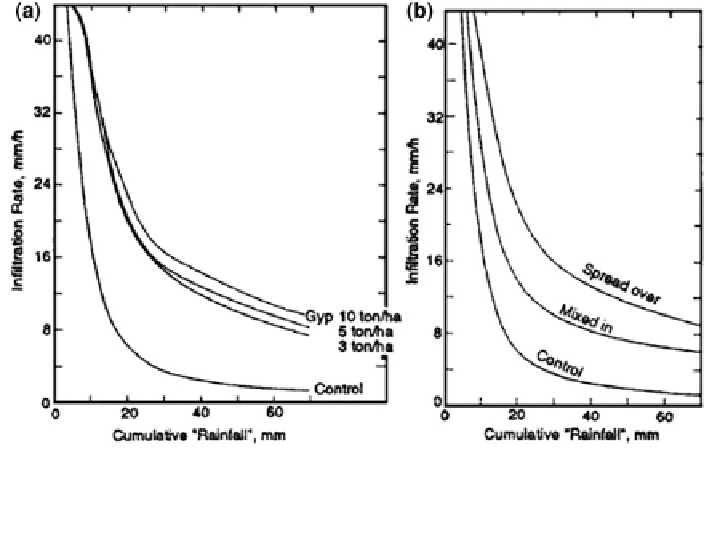Geoscience Reference
In-Depth Information
Fig. 18.9 Infiltration rates of loess (Nahal Oz) as a function of cumulative-simulated rainfall:
a the effect of quantities of applied gypsum, and b the effect of method of application, at a rate of
5 t/ha (Agassi and Ben-Hur
1992
). Reprinted from Agassi and Ben-Hur (
1992
). Copyright 1992
with permission from Elsevier
saturated hydraulic conductivity. At the soil water content of saturation, the dis-
ruption of aggregates in the soil matrix was to a certain extent irreversible (Lebron
et al.
2002
). Once an aggregate is broken, the individual particles migrate; and
under saturated conditions, formation of new aggregates is unlikely. Thus, addition
of gypsum causes irreversible changes to the water transmission properties of
sodic soils, by reducing breakdown of larger soil aggregates.
Water erosion and runoff are natural processes occurring on geomorphologic
slopes, when the impact of raindrops induces formation of a thin surface layers
(seals) on the soil. Under these processes, soil morphology changes due to dis-
persion of soil particles in the upper section of a slope and deposition of sediments
in the lower section. Application of gypsum (both mined and of byproduct origin)
on soil surfaces may cause irreversible changes to the patterns of this process.
We consider rain simulator studies on a stable sandy loamy soil, from the coastal
plain of Israel, to illustrate the effects of gypsum amendment on water erosion and
runoff (e.g., Kazman et al.
1983
; Warrington et al.
1989
; Agassi et al.
1990
; Agassi
and Ben-Hur
1991
). Figure
18.10
shows the effects of phosphogypsum addition on
the infiltration rate and loss of soil caused by rainfall-induced erosion. Seal for-
mation at the soil surface exposed to rainfall is caused by the breakdown of soil
aggregates by raindrops, and by physicochemical dispersion of clay soil that
migrates and clogs pores beneath the soil surface. The data shown in Fig.
18.10
demonstrate that phosphogypsum spread over the soil surface prevented clay dis-
persion, thus increasing infiltration and decreasing the depth of runoff. The decrease

